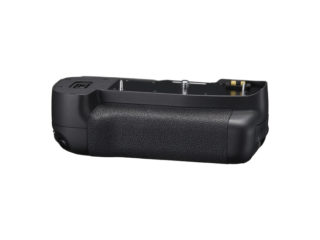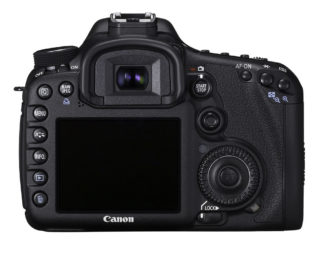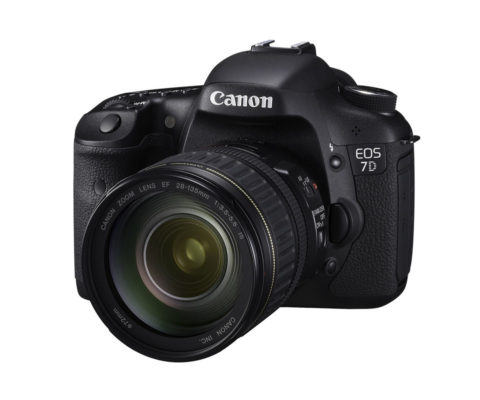Some Thoughts on Canon’s New EOS 7D
 Well it seems the rumor mill was right on this one. Canon’s first announcement for the fall season was the EOS 7D as expected. With an 18 megapixel sensor stuffed into Canon’s 22.3mm x 14.9mm APS-C format, the 7D promises to be a bit noisy, if only from the 8 frame per second motor drive.
Well it seems the rumor mill was right on this one. Canon’s first announcement for the fall season was the EOS 7D as expected. With an 18 megapixel sensor stuffed into Canon’s 22.3mm x 14.9mm APS-C format, the 7D promises to be a bit noisy, if only from the 8 frame per second motor drive.
However, as un-compelling as I thought the 7D would turn out, mostly due to cramming more pixels in an already small sensor, it carries some interesting improvements over the EOS 50D. Even more so, in terms of the user interface and customization options, the 7D looks like an improvement over all of Canon’s camera’s to date.
Key Features
- 100% viewfinder
- 19 point autofocus system
- ±3 stop metering range for exposure and flash exposure compensation
- 8 FPS
- ISO 100-6400 native, ISO 50-25600 expanded
- Transparent LCD in viewfinder to display AF points and grid lines
- E-TTL II commander mode
The EOS 7D supports the same ISO expansion options as the EOS 5D mark 2, specifically 2 stops over and 1 stop under the native range. That is a native ISO range is between ISO 100 and ISO 6400 in 1/3rd, 1/2 and full stop increments. In addition, ISO 50, ISO 12800 and ISO 25600 expanded settings are provided.
The 7D’s exposure meter now supports the same ±3 stop range of exposure compensation as seen in the EOS 1 bodies, something that’s not found even in the 5D Mark 2.
Video on dSLRs and Usability
Canon has made some significant interface changes that are evident of their continued desire to promote video on their SLRs. Access to video recording is now available though a selector switch that surrounds the new live view button. With the switch in one position, pressing the button activates live view; in the other, it begins recording video.
Canon’s focus on video as a major direction in SLR design is seen again in the 7D’s increased support for video resolutions and frame rates than any EOS body to date. Supported video modes include:
- 1080p @ 30FPS
- 1080p @ 25FPS
- 1080p @ 24FPS
- 720p @ 60FPS
- 720p @ 50FPS
- 640×580 at 60 FPS
- 640×580 at 50 FPS
The new video modes also run at NTSC and PAL standard frame rates in order to facilitate better synchronization when paired with an external recording source and compatibility with editing software.
Batteries and Grips
The 7D brings with it new  battery and wireless transfer grips. Both have the AF-On button that was lacking on the BG-E2N used with the 40D and 50D. The new grip also has the new M-Fn button by the shutter release. However neither the WFT-E5/E5A or BG-E7 have a second multi-direction selector stick (like Nikon’s MD-B10 does), so AF point selection in Multi-controller direct mode will still be limited when using the vertical grip.
battery and wireless transfer grips. Both have the AF-On button that was lacking on the BG-E2N used with the 40D and 50D. The new grip also has the new M-Fn button by the shutter release. However neither the WFT-E5/E5A or BG-E7 have a second multi-direction selector stick (like Nikon’s MD-B10 does), so AF point selection in Multi-controller direct mode will still be limited when using the vertical grip.
The EOS 7D uses the same LP-E6(Affiliate Link) as the 5D Mark 2 and the battery grip is capable of taking two such batteries. This is a nice positive for Canon shooters using a 5D mark 2 as their primary body with the 7D as a backup. However, EOS 1 users looking to use the 7D as a backup or video body are still left out in the cold with no support in from the battery grip to use LP-E4 batteries in the same way Nikon supports EN-EL4 batteries in the D300s and D700 bodies.
While the 7D may not use the same batteries as the EOS-1 series bodies, it does use the same eye-piece/viewfinder accessories. However, the 7D doesn’t have the increased nose-relief built into the EOS-1 bodies and the change in eye-pieces ends the use of the EP-EX15 eye-piece extender. 7D users will have to keep mushing their noses into the rear LCD.
Usability Improvements in the EOS 7D
 Canon has added an M-Fn button in roughly the same location as their EOS-1 bodies have the flash exposure lock button (which I find completely useless) just behind and to the side of the shutter release. Fortunately, the M-Fn button allows access to 4 operations; flash exposure lock, auto exposure lock, a RAW+JPEG mode and the viewfinder’s electronic level.
Canon has added an M-Fn button in roughly the same location as their EOS-1 bodies have the flash exposure lock button (which I find completely useless) just behind and to the side of the shutter release. Fortunately, the M-Fn button allows access to 4 operations; flash exposure lock, auto exposure lock, a RAW+JPEG mode and the viewfinder’s electronic level.
This is a nice improvement in flexibility over the EOS 1D’s UI and placement of the electronic level control makes it quite convenient, especially in light of the inclusion of the M-Fn button on the battery and wireless grips. This is a definite improvement over Nikon’s use of the Fn. button along the grip side of their lens mount.
The EOS 7D retains the top control layout of the EOS 5D mark 2 which in turn is derived from the EOS 40D and 50D. Placing the most used adjustment controls (ISO/FEC) directly behind the main dial. This is followed, in order of decreasing access frequency as you move away from the main dial, by the AF/Drive and metering/white balance. This interface is in my opinion the best interface Canon makes and a marked improvement over the interface used on the EOS 1 series bodies. I would very much like to see Canon use this across all their higher end bodies.
In addition to customization of the new M-Fn button, the EOS 7D allows for customization of almost all the controls on the camera (shutter release, AF-On, AE-Lock, DOF-Preview, Lens AF Stop, M-Fn, Set, Main dial, Quick control dial, and multi controller).
Thoughts and Conclusions
 At $1699, the EOS 7D looks to be worth the price increase over its 50D predecessor. It offers a viewfinder matched only by Canon’s EOS 1D and 1Ds models, but with more features with the inclusion of the transparent LCD display. It also provides an unmatched level of customization making it very easy to adapt to any photographers style of working. In addition, it carries the well laid out interface of the EOS 5D-II placing all of the major adjustments within a fingers reach with out having to readjust your grip while shooting.
At $1699, the EOS 7D looks to be worth the price increase over its 50D predecessor. It offers a viewfinder matched only by Canon’s EOS 1D and 1Ds models, but with more features with the inclusion of the transparent LCD display. It also provides an unmatched level of customization making it very easy to adapt to any photographers style of working. In addition, it carries the well laid out interface of the EOS 5D-II placing all of the major adjustments within a fingers reach with out having to readjust your grip while shooting.
What remains to be seen is how well Canon’s claims of improved sensor design stands up with the increasingly tiny pixels. If noise levels can be kept on par with the 50D, then the EOS 7D stands to be a very decent performer at least when it comes to printing. Of course, the even higher resolution sensor is going to demand even more from Canon’s lenses so pairing the 7D with non-L quality glass will likely be a bad idea.
DPReview and Rob Galbraith both have published hands on reviews of the EOS 7D focusing on the performance of the camera. Also, Canon USA’s EOS 7D page can be found here.
- DPReview Preview
- Rob Galbraith Preveiw
- Canon USA’s EOS 7D page can be found here..
*Press images courtesy of Canon USA